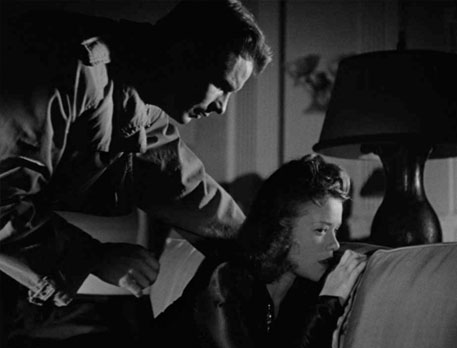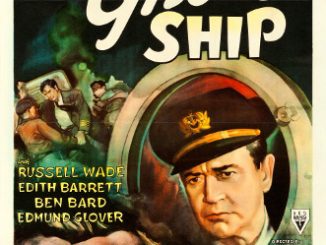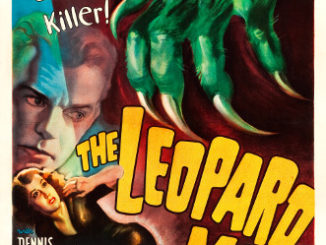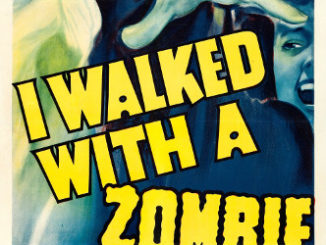Cat People (1942)
Directed by: Jacques Tourneur
Written by: DeWitt Bodeen
Starring: Jane Randolph, Kent Smith, Simone Simon, Tom Conway
USA
AVAILABLE ON BLU-RAY AND DVD
RUNNING TIME: 73 mins
REVIEWED BY: Dr Lenera, Official HCF Critic
Marine engineer Oliver Reed and Serbian-born fashion illustrator Irena Dubrovna meet and fall in love. But Irena believes in a legend involving her ancestral village. Supposedly, the inhabitants turned to witchcraft and devil worship after being enslaved by Islamic invaders, and when King John of Serbia drove them out and saw what the villagers had become, he had them killed. However, a few escaped. Irena is now convinced that something bad will happen if she’s brought to passion, but despite this, Oliver asks her to marry him, and she agrees. However, the marriage is not consummated, so Oliver persuades her to see a psychiatrist, Dr. Louis Judd, who thinks that her fears stem from childhood traumas….
It’s very rare that a series of films is named after its producer, but the name Val Lewton soon became synonymous with screen horror of the most subtle kind, based on the probably truthful idea that what you can see isn’t nearly as scary as what you can’t, while the term ‘Lewton bus’ is still sometimes used to describe when a sudden noise shatters a period of silence. He was once criticised for not having a message in his films, and replied, “I’m sorry, but we do have a message, and our message is that death is good.” Such a bold statement encapsulates the melancholic, downbeat tone of Lewton’s work, though what’s most interesting to me is that the poetic, ‘use your imagination’ approach that critics have praised to the skies came about largely because of lack of money. It wasn’t planned. Cat People, the first of these fascinating films, was originally intended to have on-screen transformation scenes and a more visible monster, but the low budget forced Lewton to go for a different approach. It’s been a great many years since I’ve seen some of these movies [I fear that in my younger years they may have seemed a bit too subtle], and a few in the Val Lewton Horror Collection boxset I’ve never seen at all, so I thought I’d gradually go through the films. I’d forgotten just how daring Cat People is. It may handle stuff in a very low key fashion, but think about it – this is 1942 – and we have a story with a very perverse sexual aspect, a woman who turns into a black panther when aroused to either anger or passion. How the hell this passed the censors of the time I don’t know, seeing how they tended to be uneasy about any kind of sexuality whatsoever. It really is a gloomy piece, and it doesn’t quite seem fully achieved to me – which makes sense in a way seeing the way its style came about. But its second half is incredibly atmospheric and the whole thing is rife with subtext.
It happened because RKO Pictures were in financial trouble after Citizen Kane proved to be an expensive commercial failure. To recoup some money, they hired Lewton, who was a journalist, novelist and poet turned story editor for David O. Selznick, to make some horror films on a budget of $150,000 to titles provided by the studio. Even back then, horror was good business. Cat People was scripted by DeWitt Bodeen from a short story by Lewton entitled The Bagheeta from 1930. It was shot on sets left over from previous, higher-budgeted RKO productions including The Magnificent Ambersons, and at the Royal Palms Hotel in Los Angeles. Both Lewton and director Jacques Tourneur came very close to being fired after only three days of shooting when Lou L. Ostrow, the head of RKO’s B-unit, looked at the first three days of rushes and wasn’t happy with what he saw. Fortunately, he was overruled by RKO chief Charles Koerner. Star Simone Simon, a major draw in her native France, frequently clashed with co-stars as well as Tourneur during the shoot largely due to her fiery temper and her attempts to upstage co-star Jane Randolph during their scenes together. On one occasion she poured coffee on one of her costumes in order to halt the production for the day because things weren’t going her way. Near the end of filming, two crews were working to finish the picture on time, one at night filming the animals in the zoo, and one during the day with the cast. Studio execs thought the film to be too subtle to compete with the more overt horror films coming from Universal and ordered some footage of the panther to be shot. But it was a huge success, and was in cinemas for so long that some critics who had originally bashed it were able to see it again and rewrote their reviews with a more positive spin, and the releases of the next two Lewton films were delayed.
Our couple first meet at the oft-used zoo area of New York’s Central Park, and immediately one thinks of what an impact the fact that this particular horror film was set in a contemporary, realistic setting – not in some fairy tale world of mad scientists, comical burgomasters, and so forth – must have had. Irena is making sketches of a black panther, and is seen throwing one away by Oliver, who proceeds to chat her up. He goes around for tea and certainly isn’t put off by this strange legend that she seems to believe in, and her saying things like, “I like the dark, it’s friendly” [it wouldn’t put me off either, in fact it might do the opposite], while the sounds of the animals in the zoo can be heard in a possible riff on a famous Dracula moment. Oliver buys her a kitten, but upon meeting her it hisses. Irena suggests they go to the pet shop to exchange it where the animals go wild in her presence, a scene that I reckon Alfred Hitchcock remembered well seeing as the beginning scene in The Birds is very similar, goodness me even some of the shots are the same. Well, Hitchcock did express admiration for Lewton’s films. “I’ve lived in dread of this moment” Irena says as Oliver moves to kiss her. Despite her unease, they get married, but during the dinner after their wedding at a Serbian restaurant, a catlike woman walks over and addresses Irena as “moya sestra” [“my sister” in Serbian]. Now it’s possible that I’m reading too much into this [I never try to sound pretentious though it probably happens sometimes], but this moment seems rather lesbian in a ‘coded’ fashion, which means that one can possibly interpret the story as an allegory about being gay, a homosexual woman feeling that, because of societal ‘normality’, she has to be part of a marriage that she can’t actually consummate. “I want to be everything that name means to me, and I can’t” she says on the wedding night. The two on either side of the bedroom door, him standing up in the hall clearly wanting to enter, and her inside the room kneeling down at the door clawing a little at it, says it all.
It’s all a bit like Marnie [Hitchcock again], and not just the film but also the book it was based on when Oliver suggests that she sees a psychiatrist – though it happens to be a psychiatrist with a voice like George Sanders so you already get the idea that he might not exactly be the best psychiatrist that she could be seeing. Up to now it’s all been very talky, which in itself is not a problem but threatens to become one when you have a male lead who’s not too great. Kent Smith isn’t exactly bland, but he fails to convey the complex emotions his character is clearly having, and the scenes between him and Jane Randolph as Alice, the workmate he begins to get closer to, aren’t too good because Randolph’s not great either in her dialogue scenes. But all this is forgiven when Jane thinks that footsteps are following her as she walks on a dark and deserted street at night. What’s weird is that it’s pretty obvious that they’ve filmed her passing the same section several times, but it adds to the unease, it’s almost dreamlike. A bus drives up to provide the first – yes – Lewton bus, and Alice knows she saw something, but all we saw were a shadow and rustling leaves. But the high point is a still frightening scene when Alice is in a swimming pool while something growls and paces as light reflected from the surface of the pool causes creepy patterns to form on the walls. We really feel Alice’s fear as we are basically experiencing horror distilled to its very essence; a person alone, and very vulnerable, with something. I enjoy the visceral stuff, but I sometimes think that my heart truly lies with this kind of thing, where our imaginations have to do some of the work. I’m not sure that the added shots of a panther in a later scene quite come off, they jar a bit with the overall reticence employed elsewhere, though some simple animated felines in a brief dream sequence are oddly unsettling even though they probably shouldn’t be.
Special effects? Well, there aren’t any really to speak of, with the only full-on attack scene done entirely in silhouette and disguised in shadows – and by this time we’ve got so used to the way things are being done that we accept this, it doesn’t feel as if we’re being cheated. In fact, it’s got to the stage where you don’t particularly want to see a lot of stuff, so effective is the film’s approach. Saying that, the climax seems a little rushed, including even the very final scene, though I guess its brevity adds a perhaps appropriate layer of cynicism to the enterprise. It’s certainly not as if they ran out of money – Lewton brought the film in way under budget! Of course the way it’s done denies a great final moment from Simon who gives one of the best lead horror film performances of the ‘40s, even if she doesn’t make much of an attempt to alter her French accent. She’s fabulously enigmatic throughout, and at times affects a genuinely unearthly vibe, but she’s savvy enough to even give a touch of earthiness to the character at times, reminding us that Irena would love to have a conventional sexual relationship – it’s just not possible. When Irena is doing her stalking it’s interesting emotionally because, while we fear for Alice, we also have a lot of sympathy for Irena, a woman who sees that her husband is becoming, rather understandably, involved with somebody else. Irena does love him, she says as much, but she just can’t satisfy his physical needs and is too scared to even try. As for Oliver, he’s a bit of a clod, but not a bad sort really. We kind of understand when he says how he wasn’t sure if he really loved Irena, he’s just so hugely confused. On the other hand, Dr. Judd, played with relish by Tom Conway, is astonishingly perverse. He seems to be turned on by Irena not just because she’s a pretty young woman, but also because there’s a small chance that something bad might happen if he tries it on with her. Conway, especially with his eyes, is somehow able to transmit to the viewer what the already brave screenplay can’t quite do.
I think that some people today watching the film through a politically correct perspective may see it as exploiting a fear of foreigners, even if Irena is never depicted as a bad person. Seeing as it was made during World War 2, I think we can let the filmmakers off. In any case, I was more aware of how it seemed to show a fear of cats, how sneaky, inscrutable and vicious they can be – a fear that Lewton had himself. But then there’s fear of all sorts of things in this movie, yet it’s also in love with its shadows, its pools of black lovingly photographed by Nicholas Musuraca, who would go on to collaborate with director Jacques Tourneur [one needs to remember that Lewton wasn’t actually the director on these] on one of the top film noirs of all time Out Of The Past. Most, if not quite all, of the early scenes tend to look relatively naturalistic, but by the time Irena is hypnotised and her face is totally surrounded by black, you’re in a different world. Perhaps less successful is Roy Webb’s music score which incorporates some folk melodies. While the lush, string-heavy style is typical of the time and reminds us that, really, this is a love story if a very odd one, it sometimes seems a bit out of place for this particular effort. Despite my criticisms of a few things – indeed it’s my belief that the Lewton series hit its artistic peak a few films later even if this effort probably remains the best known of this cycle of pictures – Cat People is still a classic; haunting, touching, rather daring, and even possibly forward thinking. But I will make a probably controversial claim here – that the 1982 remake from Paul Schrader, made at a time when there seemed to be a phase of actually pretty bloody good remakes [i.e. The Thing, Invasion Of The Body Snatchers, The Fly], is a film that I believe to be just as good as the original movie. Maybe I’ll get to reviewing that one day.
Rating: 

















Be the first to comment